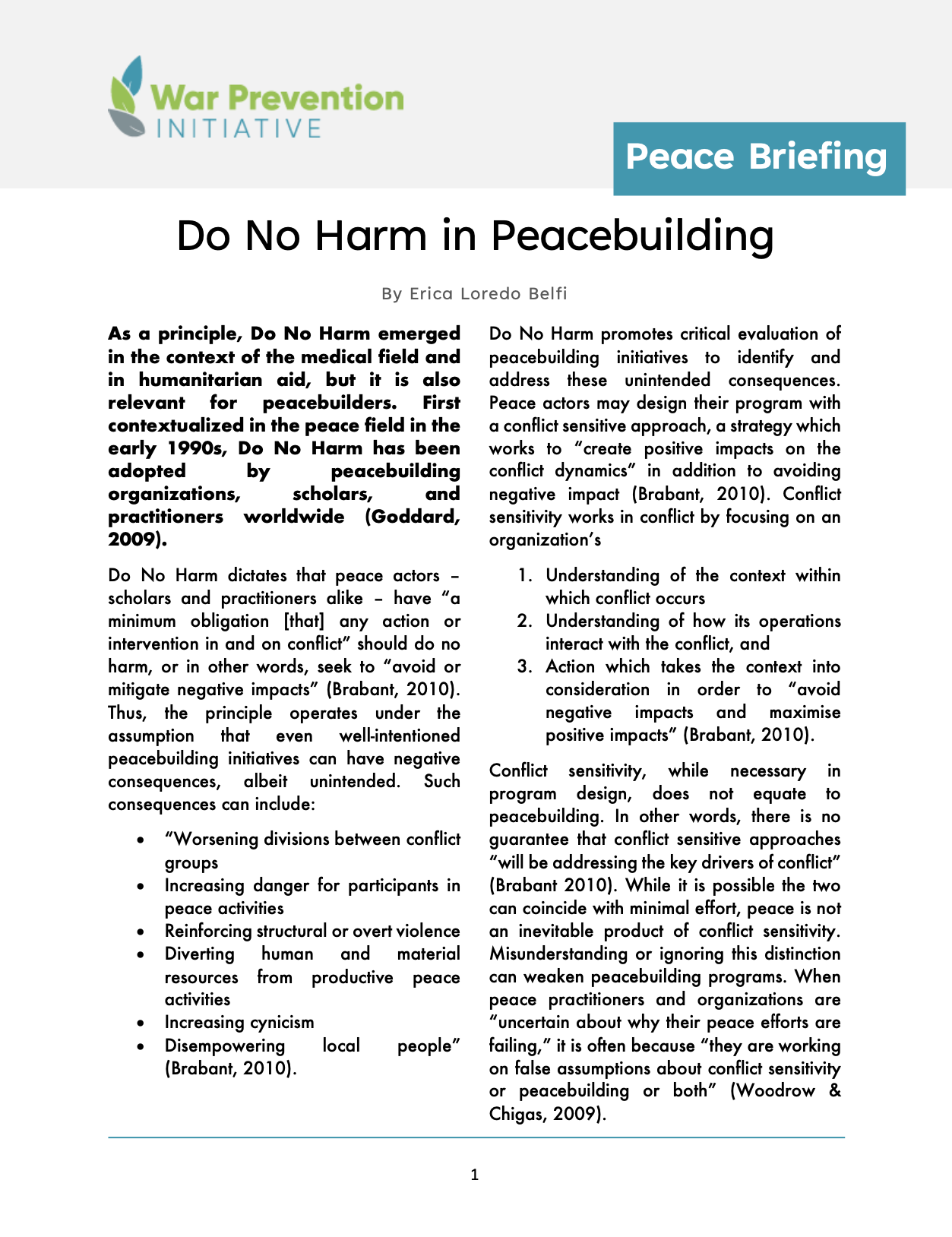By Erica Loredo Belfi
As a principle, Do No Harm emerged in the context of the medical field and in humanitarian aid, but it is also relevant for peacebuilders. First contextualized in the peace field in the early 1990s, Do No Harm has been adopted by peacebuilding organizations, scholars, and practitioners worldwide (Goddard, 2009).
Do No Harm dictates that peace actors – scholars and practitioners alike – have “a minimum obligation [that] any action or intervention in and on conflict” should do no harm, or in other words, seek to “avoid or mitigate negative impacts” (Brabant, 2010). Thus, the principle operates under the assumption that even well-intentioned peacebuilding initiatives can have negative consequences, albeit unintended. Such consequences can include:
- “Worsening divisions between conflict groups
- Increasing danger for participants in peace activities
- Reinforcing structural or overt violence
- Diverting human and material resources from productive peace activities
- Increasing cynicism
- Disempowering local people” (Brabant, 2010).
Do No Harm promotes critical evaluation of peacebuilding initiatives to identify and address these unintended consequences. Peace actors may design their program with a conflict sensitive approach, a strategy which works to “create positive impacts on the conflict dynamics” in addition to avoiding negative impact (Brabant, 2010). Conflict sensitivity works in conflict by focusing on an organization’s
- Understanding of the context within which conflict occurs
- Understanding of how its operations interact with the conflict, and
- Action which takes the context into consideration in order to “avoid negative impacts and maximise positive impacts” (Brabant, 2010).
Conflict sensitivity, while necessary in program design, does not equate to peacebuilding. In other words, there is no guarantee that conflict sensitive approaches “will be addressing the key drivers of conflict” (Brabant 2010). While it is possible the two can coincide with minimal effort, peace is not an inevitable product of conflict sensitivity. Misunderstanding or ignoring this distinction can weaken peacebuilding programs. When peace practitioners and organizations are “uncertain about why their peace efforts are failing,” it is often because “they are working on false assumptions about conflict sensitivity or peacebuilding or both” (Woodrow & Chigas, 2009).
Conflict sensitivity and Do No Harm are essential components of peacebuilding programs which must be integrated into every step of the overarching approach (Hume, 2020).
Furthermore, conflict is dynamic (Goddard, 2009). Peacebuilding actors must continually re- evaluate and adjust their approach as needed in accordance with changes in conflict. Context should be considered at the design stage, throughout, and at the end of any initiative or intervention (also called conflict mapping and conflict tracking).
Do No Harm promotes critical evaluation of peacebuilding initiatives to identify and address unintended consequences.
Implementing Do No Harm and conflict sensitivity into program design and implementation sets up peacebuilding efforts to be “more effective, accountable, and efficient” (Do No Harm: A Brief Introduction from CDA, n.d.). Programs can be made more effective by tailoring their approach to the context with which they are entering – gathering knowledge about what resources are already available, interventions others have previously tried, and relevant partners in the target area. When programs are made to anticipate potential negative effects and address them, peacebuilding practitioners can be held more accountable for their work. Lastly, initiatives are most efficient and can run more smoothly when they are contextualized and conflict sensitive.
Conflict sensitivity and Do No Harm recognize that no matter how well-intentioned or painstakingly designed peacebuilding programs are, they have the potential to cause harm. By grounding peace work in cultural, conflict, and local/regional contexts, as well as continually monitoring its impact, peace practitioners and scholars can more soundly promote peace.
Works cited
Brabant, K. V. (2010). What is Peacebuidling? Do no Harm, Conflict-Sensitivity and Peacebuilding. Interpeace. https://www.interpeace.org/wp- content/uploads/2010/08/2010_IP_What_Is_Peacebui lding_Do_No_Harm_Conflict_Sensitivity_And_Peace building.pdf
Do No Harm: A Brief Introduction From CDA. (n.d.). CDA. https://www.cdacollaborative.org/wp-content/uploads/2018/01/Do-No-Harm-A-Brief- Introduction-from-CDA.pdf
Goddard, N. (2009). Do No Harm and Peacebuilding: Five Lessons. GSDRC Applied Knowledge Services. Cambridge, MA: CDA. https://gsdrc.org/document- library/do-no-harm-and-peacebuilding-five-lessons/
Hume, E. (2020). Peacebuilding Programs in the United States: First Do No Harm. In E. Sample & D. Irvin-Erickson (Eds.), Building Peace in America (pp. 75–91). Rowman & Littlefield.
Woodrow, P., & Chigas, D. (2009). A Distinction with a Difference: Conflict Sensitivity and Peacebuilding. https://www.dmeforpeace.org/peacexchange/wp- content/uploads/2015/10/A-Distinction-with-a- Difference-Conflict-Sensitivity-and-Peacebuilding.pdf

